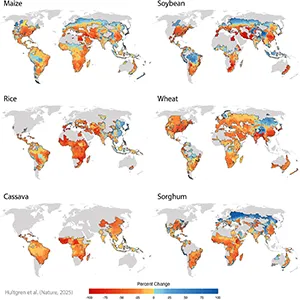Release: Strong Farms, Strong Futures Act Introduced – National Sustainable Agriculture Coalition

Legislative Developments in Sustainable Agriculture and Climate Action
Introduction of the Strong Farms, Strong Futures Act
On July 18, 2025, a bipartisan legislative proposal, the Strong Farms, Strong Futures Act, was introduced by Representatives Lauren Underwood (D-IL) and Zach Nunn (R-IA). The act aims to enhance the Conservation Stewardship Program (CSP) by directing the Natural Resources Conservation Service (NRCS) to create specialized climate change mitigation bundles. This initiative is designed to bolster the agricultural sector’s contribution to global sustainability targets.
Alignment with Sustainable Development Goals (SDGs)
The Strong Farms, Strong Futures Act directly supports the achievement of several United Nations Sustainable Development Goals (SDGs) through its focus on integrated environmental and economic resilience in agriculture.
- SDG 13: Climate Action: The core of the bill is to incentivize agricultural practices that mitigate climate change and enhance farm resilience. By establishing region-specific mitigation bundles, it promotes direct action against climate impacts in the agricultural sector.
- SDG 15: Life on Land: The act promotes ecologically sound farming systems that lead to increased soil health, directly contributing to the goals of halting land degradation and promoting the sustainable use of terrestrial ecosystems.
- SDG 6: Clean Water and Sanitation: A key co-benefit of the conservation practices encouraged by the bill is improved water quality, aligning with the goal of ensuring the availability and sustainable management of water.
- SDG 2: Zero Hunger: By making farms more resilient and profitable, the legislation supports sustainable agriculture, which is fundamental to ensuring food security and ending hunger.
- SDG 12: Responsible Consumption and Production: The bill fosters sustainable production patterns by providing financial incentives for farmers to adopt complex, innovative conservation systems that manage natural resources responsibly.
- SDG 17: Partnerships for the Goals: The bipartisan introduction of the act exemplifies a crucial partnership between political parties and government agencies (NRCS) to advance a common sustainability agenda.
Key Provisions and Intended Impacts
The legislation introduces several key mechanisms to achieve its objectives:
- Establishment of Mitigation Bundles: The NRCS will be directed to create climate change mitigation bundles tailored to specific regions and production systems within the CSP.
- Expansion of Producer Options: The act broadens the range of conservation choices available to agricultural producers, empowering them to select the most effective strategies for their operations.
- Increased Financial Support: It provides enhanced financial assistance (cost-share) for producers who implement comprehensive conservation systems that improve climate resilience, soil health, and water quality.
- Incentivizing Leadership: The highest levels of financial support are targeted toward producers undertaking the most complex and innovative conservation work, rewarding leadership in sustainable agriculture.
Stakeholder Assessment
The National Sustainable Agriculture Coalition (NSAC) has issued a statement in support of the act, highlighting its potential to advance sustainable farming practices.
- According to Jesse Womack, Conservation Policy Specialist at NSAC, the legislation strengthens the Conservation Stewardship Program’s capacity to support farmers.
- The bill is seen as a vehicle for providing robust cost-share assistance to producers building innovative conservation systems.
- NSAC anticipates that these systems will make farms more resilient, profitable, and ecologically sound, aligning with long-term sustainability objectives.
Analysis of Sustainable Development Goals in the Article
1. Which SDGs are addressed or connected to the issues highlighted in the article?
The article on the “Strong Farms, Strong Futures Act” connects to several Sustainable Development Goals (SDGs) by focusing on the intersection of agriculture, environmental protection, and economic support for farmers.
-
SDG 2: Zero Hunger
This goal is addressed through the article’s focus on sustainable agriculture. The bill aims to create “Strong Farms” which are fundamental to food security. By promoting “innovative conservation systems,” the act supports resilient and sustainable food production, which is a core component of SDG 2.
-
SDG 6: Clean Water and Sanitation
The article explicitly mentions that the practices supported by the bill provide “additional benefits like increased soil health and water quality.” This directly links the legislation to the objective of protecting and improving water resources.
-
SDG 13: Climate Action
This is a central theme of the article. The bill directs the NRCS to establish “region and production-specific climate change mitigation bundles” and increases support for practices that “improve climate resilience.” It aims to empower producers to be leaders in “America’s ongoing efforts to build innovative conservation systems” to combat climate change.
-
SDG 15: Life on Land
The goal of protecting terrestrial ecosystems is relevant due to the bill’s emphasis on improving “soil health.” Healthy soil is critical for preventing land degradation and maintaining biodiversity on agricultural lands.
-
SDG 17: Partnerships for the Goals
The article describes a legislative effort, the “Strong Farms, Strong Futures Act,” introduced by bipartisan representatives. This act represents a policy and institutional mechanism to achieve sustainable development, reflecting the spirit of partnership between government (NRCS), policymakers, and agricultural producers to implement sustainable practices.
2. What specific targets under those SDGs can be identified based on the article’s content?
The article’s content points to several specific SDG targets:
-
Target 2.4
“By 2030, ensure sustainable food production systems and implement resilient agricultural practices that increase productivity and production, that help maintain ecosystems, that strengthen capacity for adaptation to climate change… and that progressively improve land and soil quality.”
Explanation: The bill’s focus on making farms “more resilient, profitable, and ecologically sound” through “innovative conservation systems,” improved “climate resilience,” and “increased soil health” directly aligns with the objectives of this target.
-
Target 13.1
“Strengthen resilience and adaptive capacity to climate-related hazards and natural disasters in all countries.”
Explanation: The article highlights that the bill supports practices that “improve climate resilience” and helps producers expand their “climate stewardship.” This directly contributes to building the adaptive capacity of the agricultural sector to climate change.
-
Target 6.3
“By 2030, improve water quality by reducing pollution…”
Explanation: The article explicitly states that one of the benefits of the conservation practices promoted by the act is “increased… water quality,” which is the primary goal of this target.
-
Target 15.3
“By 2030, combat desertification, restore degraded land and soil… and strive to achieve a land degradation-neutral world.”
Explanation: The mention of “increased soil health” as a key benefit of the proposed agricultural practices directly supports the goal of restoring land and soil quality.
-
Target 17.14
“Enhance policy coherence for sustainable development.”
Explanation: The introduction of the “Strong Farms, Strong Futures Act” is a concrete example of creating a federal policy designed to align agricultural support systems (like the Conservation Stewardship Program) with sustainable development objectives, particularly climate action and environmental protection.
3. Are there any indicators mentioned or implied in the article that can be used to measure progress towards the identified targets?
The article does not mention official SDG indicators, but it implies several metrics that could be used to measure the success and impact of the “Strong Farms, Strong Futures Act”:
- Number of producers utilizing the program: Progress could be measured by tracking the number of producers who adopt the “climate change mitigation bundles” offered through the Conservation Stewardship Program (CSP).
- Level of financial support disbursed: The article mentions “increased financial support” and “robust cost-share.” An indicator would be the total amount of funds provided to producers for implementing complex conservation systems.
- Adoption of specific conservation practices: The article refers to “complex, innovative conservation systems.” Measuring the uptake of these specific systems (e.g., acres under new management practices) would be a direct indicator of progress.
- Regional and production-specific plans established: A key directive of the bill is for the NRCS to establish “region and production-specific climate change mitigation bundles.” An indicator of progress would be the number and variety of these bundles created and made available to producers.
4. Table of SDGs, Targets, and Indicators
| SDGs | Targets | Indicators (Implied from the Article) |
|---|---|---|
| SDG 2: Zero Hunger | Target 2.4: Ensure sustainable food production systems and implement resilient agricultural practices. |
|
| SDG 13: Climate Action | Target 13.1: Strengthen resilience and adaptive capacity to climate-related hazards. |
|
| SDG 6: Clean Water and Sanitation | Target 6.3: Improve water quality by reducing pollution. |
|
| SDG 15: Life on Land | Target 15.3: Combat desertification, restore degraded land and soil. |
|
| SDG 17: Partnerships for the Goals | Target 17.14: Enhance policy coherence for sustainable development. |
|
Source: sustainableagriculture.net

What is Your Reaction?
 Like
0
Like
0
 Dislike
0
Dislike
0
 Love
0
Love
0
 Funny
0
Funny
0
 Angry
0
Angry
0
 Sad
0
Sad
0
 Wow
0
Wow
0












































































